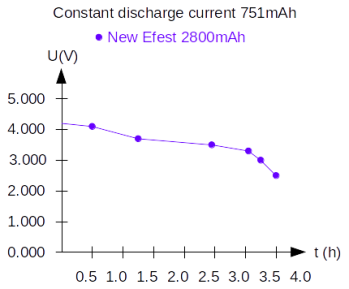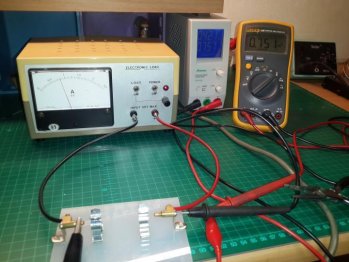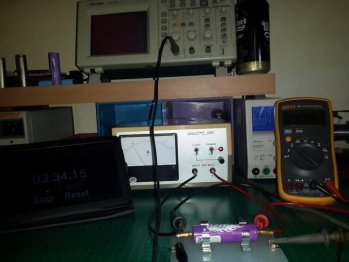Navigation
Install the app
How to install the app on iOS
Follow along with the video below to see how to install our site as a web app on your home screen.

Note: this_feature_currently_requires_accessing_site_using_safari
More options
You are using an out of date browser. It may not display this or other websites correctly.
You should upgrade or use an alternative browser.
You should upgrade or use an alternative browser.
New Efest 18650's - confusion
- Thread starter KB_314
- Start date
Did some tests on one of the new efests end of last week. Will submit some info as soon as Helkom restored DSL.
via Tapatalk
Awesome
Did some tests on one of the new efests end of last week. Will submit some info as soon as Helkom restored DSL.
via Tapatalk
Great news, really looking forward to your findings
On the other front, sorry to hear about the DSL. I was wondering why you've been so quiet lately - I was starting to miss you
Dankie meneer, vertrou jou bevindings meer as die intawebs 
Great news, really looking forward to your findings
On the other front, sorry to hear about the DSL. I was wondering why you've been so quiet lately - I was starting to miss you
Now you don't need to miss me anymore
Dankie meneer, vertrou jou bevindings meer as die intawebs
Ek gaan hierdie boodskap uitdruk en vir my vrou gee
Now you don't need to miss me anymore- it took Helkom over 1550 new forum posts to restore DSL connection
.
Finally
I think new forum posts as a measure of time should be the standard
Busy typing a huge love letter (more like editing out technical jargon) regarding the new Efest 2800mAh battery. Here's a teaser (Y axis = Battery voltage under constant load & X axis = time in hours):
That looks promising...looking forward to the love letter
some stats on the website below with regards to these pretty good looking batteries....
http://ukvapers.org/Thread-35A-Efest-2800mAh-18650-battery
http://ukvapers.org/Thread-35A-Efest-2800mAh-18650-battery
Anyone have any opinion on the purple Efest IMR18650 3.7v Li-Mn 3100mAh 20A?
Anyone have any opinion on the purple Efest IMR18650 3.7v Li-Mn 3100mAh 20A?
It's a great battery...just keep the coil resistance in the higher range (0.7 and up) and <50W and they work like a charm...nice battery life
I received one of the new purple wrapped Efest batteries from @Philip Dunkley about 2 weeks ago, which he obtained from SkyBlue. Only once I accepted the gifted battery I was told its for testing purposes
Firstly, I fully charged the Efest 2800mAh (35A) battery with a Lab power supply: 4.225V constant voltage & 1.0A constant current. The battery was rested at room temperature for +/-2 hours. I had to make do with what was at hand regarding testing equipment as some of the stuff I needed are already en route to Dublin in a container.
Make do setup (that adjustable constant load in picture is over 30 years old and bound for the bin):
The first test conducted was to determine internal resistance (IR). The official Efest data sheet claimed: <10 milliohm ("initial impedance"). PS. For all practical purposes in these direct current (DC) tests, impedance = resistance.
Procedure:
- Measure battery voltage without load (VNL)
- Measure resistance of constant load (RL)
- Measure current (Ic) when constant load is connected to battery (<100ms)
- Measure battery voltage under constant load (VL)
- Calculate internal resistance: IR = (VNL - VL) / Ic
IR = 0.040 Ohm (or 40 milliohm)
0.04 Ohm is extremely good compared to other batteries in my vape box, but still much higher than the claimed <0.01 Ohm - and thats is maybe why they added the term "initial" in their data sheet. Just out of interest, here are some measured IR's from various other brand batteries tested:
- Efest 3100mAh (last year's generation) = 0.15 Ohm
- fAW 2000mAh = 0.11 Ohm
- LG IMR 2400mAh - 0.10 Ohm
Above test answered my question why I could vape the extra 1 to 2ml, compared to other batteries.
Internal battery resistance is the gatekeeper that, to a large extent, determines the "runtime". The lower the resistance, the less restriction the battery encounters in delivering the needed power. The internal resistance (IR) of a battery is defined as the opposing force to the flow of current within the battery. There are two basic components that impact the internal resistance of a battery; they are; electronic resistance (internal and external conductors) and ionic resistance (electrolyte and di-electric).
The battery cell's internal resistance levels are highest at low state-of-charge and immediately after charging. Contrary to popular belief, the best battery performance is not achieved immediately after a full charge but following a rest period of a couple of hours.
The internal resistance of a cell is closely related to its capacity and can, therefore, be used to predict the cell’s performance during a discharge. Even though there is a close correlation between a battery cell’s internal resistance and its capacity, it is not completely linear. The resistance measurement is, therefore, not used as a direct indicator of capacity, but, rather, as a warning indicator that signals if a cell has deteriorated to a level that will affect the operating integrity of the system. Field testing on all types of batteries has proven that, if a cell’s internal resistance increases to more than 25% above its known good base line value, that cell will fail a capacity test.
Next I moved over to the capacity (C) test of the battery to compare against the datasheet claim of: "2800mAh typical".
Procedure:
- Charge battery as above and rest for 2 hours
- Connect to constant current load (751mA)
- Note exact time when battery voltage discharge to 2.50V
- Calculate battery capaity: C = Load x t
C = 2.68107Ah (or 2681mAh) - this is acceptable to me.
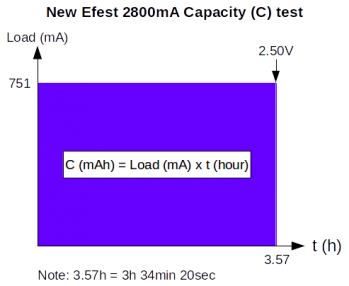
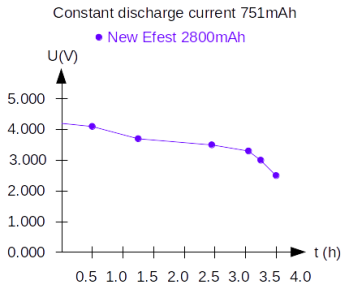
Time (hour:minute:second) period // discharge voltage under constant load:
0:00:00 = 4.21V
1:14:43 = 3.70V
2:27:53 = 3.50V
3:11:37 = 3.30V
3:24:10 = 3.00V
3:34:20 = 2.50V
It would be unfair to do comparative capacity tests of the other batteries I have on hand due to the difference in age and hence cycle history.
Unfortunately I don't have any bigger constant load than 44W to double check the 35A continuous discharge current and/or the 80A pulse discharge claims according to the data sheet and I don't really doubt the claims either. I did take some measurements with a 0.4 Ohm constant load over a period of 10sec to determine the voltage drop compared to other batteries on hand.
0:00:00 = 4.21V
1:14:43 = 3.70V
2:27:53 = 3.50V
3:11:37 = 3.30V
3:24:10 = 3.00V
3:34:20 = 2.50V
It would be unfair to do comparative capacity tests of the other batteries I have on hand due to the difference in age and hence cycle history.
Unfortunately I don't have any bigger constant load than 44W to double check the 35A continuous discharge current and/or the 80A pulse discharge claims according to the data sheet and I don't really doubt the claims either. I did take some measurements with a 0.4 Ohm constant load over a period of 10sec to determine the voltage drop compared to other batteries on hand.
New Efest 2800mAh @ 10.5A constant load over a 10sec period, showed a voltage drop of only 0.58V at the 10sec mark compared to an average of 0.87V on all other batteries tested. The rise in internal resistance was a mere 0.02 ohm under load.
In summary, I am really impressed with this battery, whether re-wrapped or not. Battery capacity (mAh) in the vaper's world, is definitely not the alpha and omega, check the internal resistance on the data sheet
Officicial data sheet of new Efest 2800mAh battery attached.
Attachments
Oh WOW! That's all above my pay grade but it looks to me like these batteries are a winner! 
Oh WOW! That's all above my pay grade but it looks to me like these batteries are a winner!
No its below your pay grade, I only got paid a now used purple battery, not blue screw drivers
Amazing post @johan 
This taught me more about battery operation than all the other combined research I've done...not to mention the fact that you've shone a great deal of light on the performance of these batteries.
So the bottom line is that they are great, even if they don't fully live up to their printed specifications (which are just marketing numbers in a sense, from what I've learned by reading your post).
I have had a similar experience to you - they do seem to last noticeably longer before I sense a drop when using them on my Reo (about 4-5ml @ 0.7Ohm). I foolishly put that down only to them being newer, but now I know better
This taught me more about battery operation than all the other combined research I've done...not to mention the fact that you've shone a great deal of light on the performance of these batteries.
So the bottom line is that they are great, even if they don't fully live up to their printed specifications (which are just marketing numbers in a sense, from what I've learned by reading your post).
I have had a similar experience to you - they do seem to last noticeably longer before I sense a drop when using them on my Reo (about 4-5ml @ 0.7Ohm). I foolishly put that down only to them being newer, but now I know better
Wow, great post, very informative, thank you @johan
And now I learnt something new:
Going on your results this is definitely my next purchase.
And now I learnt something new:
I need to start including a rest period between battery changesThe battery cell's internal resistance levels are highest at low state-of-charge and immediately after charging. Contrary to popular belief, the best battery performance is not achieved immediately after a full charge but following a rest period of a couple of hours.
Going on your results this is definitely my next purchase.
@johan WOW, when I handed this over, all I was really expecting was a good or bad answer. This is very impressive, thank you so much for such detailed information!!! At least we have an idea now, that once again there is marketing blurb but that they are also great batteries!! These will become my defacto going forward. Thank you again mate
@Melinda and @Derick , you can sleep soundly now knowing that the new batteries are great!!!
@Melinda and @Derick , you can sleep soundly now knowing that the new batteries are great!!!
Thank you @johan. Most impressive. Together with the test @JW Flynn linked above, seems this is a great buy.
And, if I understand correctly, the terms "maximum continuous discharge current" and "continuous discharge current", which confused us on the first page of this thread, are the same and can be regarded as 35A. I have not received an answer from Efest in this regard.
And, if I understand correctly, the terms "maximum continuous discharge current" and "continuous discharge current", which confused us on the first page of this thread, are the same and can be regarded as 35A. I have not received an answer from Efest in this regard.
Thank you @johan. Most impressive. Together with the test @JW Flynn linked above, seems this is a great buy.
And, if I understand correctly, the terms "maximum continuous discharge current" and "continuous discharge current", which confused us on the first page of this thread, are the same and can be regarded as 35A. I have not received an answer from Efest in this regard.
According to the official Efest data sheet there is no mention of the confusing: "maximum continuous discharge current" and "continuous discharge current". Yes you are correct in your assumption: continuous = 35A maximum [and pulse (smaller /equal to 1sec period) = 80A].
I decided to wait a while to post my opinion on these batteries. I've been using them now for about 3 weeks or so and I just bought two more yesterday at VapeCon.
I concur with Ohm Johan's assessment of the longer vaping time on the Reo. Normally, with the Efest 2500 and the Samsung 25R I would fill my bottle only just above half and have a good vape all the way to empty, but with these I can fill my bottle to 3/4 and have the same experience right through to empty. That's saying something to me.
I don't have the electronics knowledge of Ohm Johan (his equations make my head hurt) and/or tools to test batteries properly like he does, so my above opinion is purely based on personal experience and I prefer these new ones above the old ones and the smurfs.
These new ones also keep their charge after taking them out of the charger. I've had one stand for a day and when I put it back into the charger to check, it showed 4.2 volts. The old 2500's also did that, but not my smurfs. They still go down to 4.16 after just a few hours outside the charger.
So my choice of batteries is obvious.
Again, just my opinion.
I concur with Ohm Johan's assessment of the longer vaping time on the Reo. Normally, with the Efest 2500 and the Samsung 25R I would fill my bottle only just above half and have a good vape all the way to empty, but with these I can fill my bottle to 3/4 and have the same experience right through to empty. That's saying something to me.
I don't have the electronics knowledge of Ohm Johan (his equations make my head hurt) and/or tools to test batteries properly like he does, so my above opinion is purely based on personal experience and I prefer these new ones above the old ones and the smurfs.
These new ones also keep their charge after taking them out of the charger. I've had one stand for a day and when I put it back into the charger to check, it showed 4.2 volts. The old 2500's also did that, but not my smurfs. They still go down to 4.16 after just a few hours outside the charger.
So my choice of batteries is obvious.
Again, just my opinion.
I decided to wait a while to post my opinion on these batteries. I've been using them now for about 3 weeks or so and I just bought two more yesterday at VapeCon.
I concur with Ohm Johan's assessment of the longer vaping time on the Reo. Normally, with the Efest 2500 and the Samsung 25R I would fill my bottle only just above half and have a good vape all the way to empty, but with these I can fill my bottle to 3/4 and have the same experience right through to empty. That's saying something to me.
I don't have the electronics knowledge of Ohm Johan (his equations make my head hurt) and/or tools to test batteries properly like he does, so my above opinion is purely based on personal experience and I prefer these new ones above the old ones and the smurfs.
These new ones also keep their charge after taking them out of the charger. I've had one stand for a day and when I put it back into the charger to check, it showed 4.2 volts. The old 2500's also did that, but not my smurfs. They still go down to 4.16 after just a few hours outside the charger.
So my choice of batteries is obvious.
Again, just my opinion.
Thanks for the feedback @zadiac
Most helpful to have a personal experience supporting Ohm Johan's findings
Now why didnt I buy any of these yesterday? Lol? Sigh...
Similar threads
- Replies
- 2
- Views
- 4K
- Replies
- 3
- Views
- 446
- Replies
- 0
- Views
- 296
- Replies
- 0
- Views
- 394


